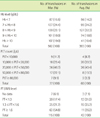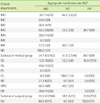1. Um TH, Whang DH, Chang YH, Hur M, Kang HJ, editors. Transfusion Guideline. 2009. Seoul: Division of Human Blood Safety Surveillance, Korea Centers for Disease Control and Prevention.
2. Liumbruno GM, Rafanelli D. Appropriateness of blood transfusion and physicians' education: a continuous challenge for Hospital Transfusion Committees? Blood Transfus. 2012. 10:1–3.
3. Hessel EA 2nd, Levy JH. Guidelines for perioperative blood transfusion and conservation in cardiac surgery: lessons and challenges. Anesth Analg. 2010. 111:1555–1559.

4. Treleaven J, Gennery A, Marsh J, Norfolk D, Page L, Parker A, et al. Guidelines on the use of irradiated blood components prepared by the British Committee for Standards in Haematology blood transfusion task force. Br J Haematol. 2011. 152:35–51.

5. Westbrook A, Pettila V, Nichol A, Bailey MJ, Syres G, Murray L, et al. Transfusion practice and guidelines in Australian and New Zealand intensive care units. Intensive Care Med. 2010. 36:1138–1146.

6. Roback JD, Caldwell S, Carson J, Davenport R, Drew MJ, Eder A, et al. Evidence-based practice guidelines for plasma transfusion. Transfusion. 2010. 50:1227–1239.

7. Tinmouth AT, Hare GM, Mazer CD. The "sticky" business of "adherence" to transfusion guidelines. Intensive Care Med. 2010. 36:1107–1109.

8. Kim H, Park KU, Han KS. Blood utilization: audit of transfusion practice using an electronic review system. Korean J Blood Transfus. 2010. 21:93–104.
9. Simon TL, Alverson DC, AuBuchon J, Cooper ES, DeChristopher PJ, Glenn GC, et al. Practice parameter for the use of red blood cell transfusions: developed by the Red Blood Cell Administration Practice Guideline Development Task Force of the College of American Pathologists. Arch Pathol Lab Med. 1998. 122:130–138.
10. Vincent JL, Piagnerelli M. Transfusion in the intensive care unit. Crit Care Med. 2006. 34:s96–s101.

11. Hebert PC, Yetisir E, Martin C, Blajchman MA, Wells G, Marshall J, et al. Is a low transfusion threshold safe in critically ill patients with cardiovascular diseases? Crit Care Med. 2001. 29:227–234.

12. Gould S, Cimino MJ, Gerber DR. Packed red blood cell transfusion in the intensive care unit: limitations and consequences. Am J Crit Care. 2007. 16:39–48.

13. Davenport RD. The red blood cell transfusion threshold: evidence and outcome. Curr Hematol Rep. 2002. 1:142–148.
14. Beale E, Zhu J, Chan L, Shulman I, Harwood R, Demetriades D. Blood transfusion in critically injured patients: a prospective study. Injury. 2006. 37:455–465.

15. Chohan SS, McArdle F, McClelland DB, Mackenzie SJ, Walsh TS. Red cell transfusion practice following the transfusion requirements in critical care (TRICC) study: prospective observational cohort study in a large UK intensive care unit. Vox Sang. 2003. 84:211–218.

16. Goodnough LT, Vizmeg K, Riddell J 4th, Soegiarso RW. Discharge haematocrit as clinical indicator for blood transfusion audit in surgery patients. Transfus Med. 1994. 4:35–44.

17. Kim YH, Chung ES, Im SA, Chung RK, Kim SC, Lee ML, et al. Evaluation of the appropriateness of red cells, platelets and fresh frozen plasma utilization. Korean J Lab Med. 2003. 23:448–454.
18. Lawrence JB, Yomtovian RA, Hammons T, Masarik SR, Chongkolwatana V, Creger RJ, et al. Lowering the prophylactic platelet transfusion threshold: a prospective analysis. Leuk Lymphoma. 2001. 41:67–76.

19. Sagmeister M, Oec L, Gmur J. A restrictive platelet transfusion policy allowing long-term support of outpatients with severe aplastic anemia. Blood. 1999. 93:3124–3126.

20. Wandt H, Frank M, Ehninger G, Schneider C, Brack N, Daoud A, et al. Safety and cost effectiveness of a 10×10
9/L trigger for prophylactic platelet transfusions compared with the traditional 20×10
9/L trigger: a prospective comparative trial in 105 patients with acute myeloid leukemia. Blood. 1998. 91:3601–3606.

21. Rebulla P, Finazzi G, Marangoni F, Avvisati G, Gugliotta L, Tognoni G, et al. The threshold for prophylactic platelet transfusions in adults with acute myeloid leukemia. Gruppo Italiano Malattie Ematologiche Maligne dell'Adulto. N Engl J Med. 1997. 337:1870–1875.

22. Kang SG, Kwon SW. Analysis of Appropriateness and Efficacy of Fresh Frozen Plasma Transfusion. Korean J Lab Med. 2002. 22:278–285.
23. Metz J, McGrath KM, Copperchini ML, Haeusler M, Haysom HE, Gibson PR, et al. Appropriateness of transfusions of red cells, platelets and fresh frozen plasma. An audit in a tertiary care teaching hospital. Med J Aust. 1995. 162:572–573. 576–577.
24. Novis DA, Renner S, Friedberg R, Walsh MK, Saladino AJ. Quality indicators of blood utilization: three College of American Pathologists Q-Probes studies of 12,288, 404 red blood cell units in 1639 hospitals. Arch Pathol Lab Med. 2002. 02. 126:150–156.
25. Cheema B, Molyneux EM, Emmanuel JC, M'Baya B, Esan M, Kamwendo H, et al. Development and evaluation of a new paediatric blood transfusion protocol for Africa. Transfus Med. 2010. 20:140–151.








 PDF
PDF ePub
ePub Citation
Citation Print
Print




 XML Download
XML Download